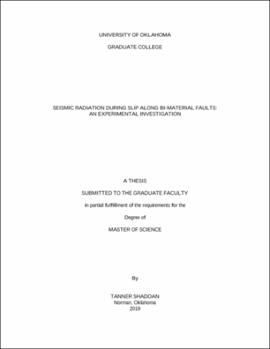| dc.description.abstract | Large slip along faults is likely to place crustal blocks of different lithological and mechanical properties against one another, a process that forms a bi-material fault. To explore the behavior of such faults, I conducted shear experiments on bimaterial-faults and analyzed the characteristics of laboratory earthquakes. The experimental faults were composed of two blocks of gabbro, dolomite, and sandstone, forming nine lithological combinations. The blocks were in contact by a ring-shaped fault and were loaded in a rotary shear apparatus (ROGA) at the University of Oklahoma. Slip rates and normal stresses ranged from 0.25µm/s to 1cm/s and 0.5 to 15 MPa, respectively. I performed constant velocity experiments and monitored the seismic radiation, via acoustic emissions, along the fault surface with four 3D accelerometers mounted ~2 cm away from the experimental fault at a rate of 1 MHz.
I analyzed acoustic emissions (laboratory earthquakes) using traditional seismological techniques. The experiments show distinct dependence of seismic radiation on (1) the mechanical contrast between the two blocks that controls the rupture characteristics, and (2) the mechanical properties of the blocks that control the nature of the ray path of the acoustic waves. For example, the Gutenberg-Richter relationship revealed that experiments containing gabbro and dolomite, a bi-material fault, have intermediate behavior and mimic both end members of the single lithology faults of gabbro and dolomite. Furthermore, frequency spectrum data revealed the differences in seismic radiation due to rupture and ray path characteristics. For example, for an experimental fault composed of gabbro and sandstone, the recorded events on the more compliant side (sandstone) of the fault have low amplitudes (low accelerations) at higher frequencies. I deduced that the ray path, which is controlled by the rock properties, is responsible for this difference. The analysis showed that while keeping the ray path constant (i.e. dolomite) but changing the other fault rock, to either gabbro, sandstone, or dolomite, will still observe differences in the frequency content, this time due to rupture characteristics of the laboratory earthquakes.
The experiments show the distinct dependence of seismic radiation on the mechanical properties of the fault lithologies and their contrast. Further, they indicate that the nature of a bimaterial fault has strong control on the mechanisms of fault rupture and the frequency content of seismic radiation. | en_US |
